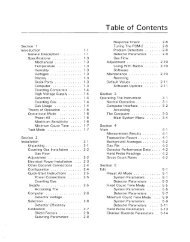Gilson and Voss - Voss Associates
Gilson and Voss - Voss Associates
Gilson and Voss - Voss Associates
You also want an ePaper? Increase the reach of your titles
YUMPU automatically turns print PDFs into web optimized ePapers that Google loves.
AIR FLOW METER CORRECTIONS<br />
Mass Flow Meters<br />
Q S = Q A (P A /P S x T S /T A )<br />
Q A = Q S (P S /P A x T A /T S )<br />
where; Q S is the STP flow rate<br />
Q A is the ambient flow rate<br />
P S is STP pressure<br />
P A is the ambient pressure<br />
T S is STP temperature<br />
T A is the ambient temperature<br />
Rotameter Corrections<br />
Q S = Q I x P S /P A x T S /T A<br />
√(P S /P I x T A /T S )<br />
where; Q I is the rotameter flow indication<br />
P I is the actual pressure inside the rotameter.<br />
This correction assumes the rotameter markings are<br />
correct at STP. The actual pressure inside the rotameter<br />
should be used in the calculations.<br />
For personnel protection against particulate airborne<br />
radioactivity ambient sample volumes instead of volumes<br />
corrected to STP should be used for calculations. The<br />
ambient respiratory rate will remain the same as<br />
atmospheric pressure changes from STP up to an elevation<br />
of approximately 12,000 feet (3,660 Meters).<br />
Page 71<br />
AIR FLOW METER CORRECTIONS<br />
Mass Flow Meters<br />
Q S = Q A (P A /P S x T S /T A )<br />
Q A = Q S (P S /P A x T A /T S )<br />
where; Q S is the STP flow rate<br />
Q A is the ambient flow rate<br />
P S is STP pressure<br />
P A is the ambient pressure<br />
T S is STP temperature<br />
T A is the ambient temperature<br />
Rotameter Corrections<br />
Q S = Q I x P S /P A x T S /T A<br />
√(P S /P I x T A /T S )<br />
where; Q I is the rotameter flow indication<br />
P I is the actual pressure inside the rotameter.<br />
This correction assumes the rotameter markings are<br />
correct at STP. The actual pressure inside the rotameter<br />
should be used in the calculations.<br />
For personnel protection against particulate airborne<br />
radioactivity ambient sample volumes instead of volumes<br />
corrected to STP should be used for calculations. The<br />
ambient respiratory rate will remain the same as<br />
atmospheric pressure changes from STP up to an elevation<br />
of approximately 12,000 feet (3,660 Meters).<br />
Page 71<br />
AIR FLOW METER CORRECTIONS<br />
Mass Flow Meters<br />
Q S = Q A (P A /P S x T S /T A )<br />
Q A = Q S (P S /P A x T A /T S )<br />
where; Q S is the STP flow rate<br />
Q A is the ambient flow rate<br />
P S is STP pressure<br />
P A is the ambient pressure<br />
T S is STP temperature<br />
T A is the ambient temperature<br />
Rotameter Corrections<br />
Q S = Q I x P S /P A x T S /T A<br />
√(P S /P I x T A /T S )<br />
where; Q I is the rotameter flow indication<br />
P I is the actual pressure inside the rotameter.<br />
This correction assumes the rotameter markings are<br />
correct at STP. The actual pressure inside the rotameter<br />
should be used in the calculations.<br />
For personnel protection against particulate airborne<br />
radioactivity ambient sample volumes instead of volumes<br />
corrected to STP should be used for calculations. The<br />
ambient respiratory rate will remain the same as<br />
atmospheric pressure changes from STP up to an elevation<br />
of approximately 12,000 feet (3,660 Meters).<br />
Page 71<br />
AIR FLOW METER CORRECTIONS<br />
Mass Flow Meters<br />
Q S = Q A (P A /P S x T S /T A )<br />
Q A = Q S (P S /P A x T A /T S )<br />
where; Q S is the STP flow rate<br />
Q A is the ambient flow rate<br />
P S is STP pressure<br />
P A is the ambient pressure<br />
T S is STP temperature<br />
T A is the ambient temperature<br />
Rotameter Corrections<br />
Q S = Q I x P S /P A x T S /T A<br />
√(P S /P I x T A /T S )<br />
where; Q I is the rotameter flow indication<br />
P I is the actual pressure inside the rotameter.<br />
This correction assumes the rotameter markings are<br />
correct at STP. The actual pressure inside the rotameter<br />
should be used in the calculations.<br />
For personnel protection against particulate airborne<br />
radioactivity ambient sample volumes instead of volumes<br />
corrected to STP should be used for calculations. The<br />
ambient respiratory rate will remain the same as<br />
atmospheric pressure changes from STP up to an elevation<br />
of approximately 12,000 feet (3,660 Meters).<br />
Page 71













